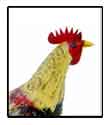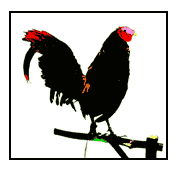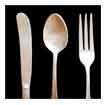
HOME
Philippines for the Intrepid Traveler |
||||||||
No other Philippine food item will evoke a combination of amusement, revulsion and incredulousness as the balut, a fertilized duck egg with its discernible (sometimes feathered) embryo, sharing shell space with a yolk and a hardened white called "bato." Long part of Filipino culinary folklore, it is considered a virility-enhancing, stamina-boosting UpYourDickSiac. . . um. . . aphrodisiac. It is not unique to the Philippines. Its origin may be Chinese, where it is called "maodan" (feathered egg). In Vietnam, it is called hot vin lon. It is also found in the fertilized egg customs of Laos, Cambodia (Ponh tea khon) and Thailand. But it is in the Philippines where it has evolved into a variety of offerings: the classic traditional suck-peel-gobble eggform, pickled balut, balut omelet, adobong balut, deep-fried, or bottled balut in its various native flavors. Although widely produced in the Philippines –
usually from the Mallard duck (Pateros itik, Anas platyrnchos)
– it is in Pateros, Rizal where balut
making has been elevated to art and science. Attention is given to incubation
time – after nine days of sun-basking, the embryo development
is confirmed by its shadowy presence within the shell revealed through
a background light. Another eight days complete the optimum cycle of
development and the duck egg is ready for cooking and consumption. The
perfect balut, called Balut sa Puti,
is 17 days old, without discernible beak, feathers and claws and underdeveloped
bones. Some prefer an additional 3 or 4 days which will allow further
development that will make the duck embryo's basic features more recognizable
and the bones firmer yet still tender. Regional rural folklore caution against the 'lethal'
combination of beer and balut as a possible cause of bangungut.
Superstitions warn pregnant women of balut-craving as a possible cause
of hairy babies or hirsutism later in life. Excessive use is also believed
to be a cause hypertension and occipital headaches. Even with those
anecdotal and folkloric concerns and the obvious serving of cholesterol
in the yolk, many believe it to be a healthy, energizing and virilizing
UpYourDickSiac . . . um. . . aphrodisiac food item. Balut is the quintessential and affordable delicacy. A male-dominated indulgence, it is a common pulutan (side dish) in an evening of drinking; for some, especially among women, it is a rite-of-passage food, the taste and craving diminished by a lasting image of a clumped feathered or beaked duck embryo. For foreigners, it is official Filipino badge-of-courage dare-and-shock-food, a Fear-Factor kind of macho-measure of intestinal fortitude, that on fearless gastronomic or alcohol-assisted consummation would merit a high-five, the pinoy "appear," the brother-handshake, fist-bump, or fist-jab.
Consumption
101 - Bottled
Balut . . . ?
Bon
appétit ! |
||||||||
For other delectable Filipino fringe and
UpYourDickSiac foods, check out the yuck-but-yummy list of
Philippine cuisine. |
| Photo ©Godofredo Stuart / StuartXchange | |
| OTHER IMAGE SOURCE: Public Domain / BALUT EGG / File:BALUT.jpg / Original uploader was Ischaramoochie at en.wikipedia / 2008-05-03 / Wikipedia | |
| More Readings for the Intrepid Traveler | |
 |
Fiestas
and Festivals |
Quiapo
|
Philippine
Cuisine: The Yucky-But-Yummy 
  |
Sabong
/ Cockfighting |
Lambanog
|
 |
 The ABCDE of the Yummy Philippine Cuisine |
Jeepney
|
|
| by Godofredo Umali Stuart | |
BACK
TO • THE INTREPID TRAVELER

HOME • SEARCH
• EMAIL
• ABOUT